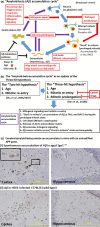"Amyloid-beta accumulation cycle" as a prevention and/or therapy target for Alzheimer's disease
- PMID: 31981470
- PMCID: PMC7059149
- DOI: 10.1111/acel.13109
"Amyloid-beta accumulation cycle" as a prevention and/or therapy target for Alzheimer's disease
Abstract
The cell cycle and its regulators are validated targets for cancer drugs. Reagents that target cells in a specific cell cycle phase (e.g., antimitotics or DNA synthesis inhibitors/replication stress inducers) have demonstrated success as broad-spectrum anticancer drugs. Cyclin-dependent kinases (CDKs) are drivers of cell cycle transitions. A CDK inhibitor, flavopiridol/alvocidib, is an FDA-approved drug for acute myeloid leukemia. Alzheimer's disease (AD) is another serious issue in contemporary medicine. The cause of AD remains elusive, although a critical role of latent amyloid-beta accumulation has emerged. Existing AD drug research and development targets include amyloid, amyloid metabolism/catabolism, tau, inflammation, cholesterol, the cholinergic system, and other neurotransmitters. However, none have been validated as therapeutically effective targets. Recent reports from AD-omics and preclinical animal models provided data supporting the long-standing notion that cell cycle progression and/or mitosis may be a valid target for AD prevention and/or therapy. This review will summarize the recent developments in AD research: (a) Mitotic re-entry, leading to the "amyloid-beta accumulation cycle," may be a prerequisite for amyloid-beta accumulation and AD pathology development; (b) AD-associated pathogens can cause cell cycle errors; (c) thirteen among 37 human AD genetic risk genes may be functionally involved in the cell cycle and/or mitosis; and (d) preclinical AD mouse models treated with CDK inhibitor showed improvements in cognitive/behavioral symptoms. If the "amyloid-beta accumulation cycle is an AD drug target" concept is proven, repurposing of cancer drugs may emerge as a new, fast-track approach for AD management in the clinic setting.
Keywords: Alzheimer's disease (AD); Shugoshin 1 (Sgo1); amyloid-beta (Aβ); brain; cell cycle; chromosome instability (CIN); cohesinopathy; cyclin-dependent kinase (CDK) inhibitor; mitosis; mouse.
© 2020 The Authors. Aging Cell published by the Anatomical Society and John Wiley & Sons Ltd.
Conflict of interest statement
No conflicts of interest declared.
Figures


References
Publication types
MeSH terms
Substances
Grants and funding
LinkOut - more resources
Full Text Sources
Other Literature Sources
Medical

